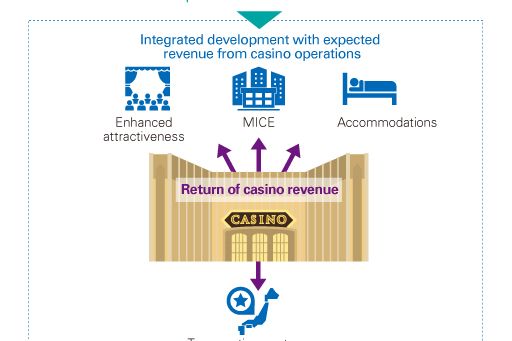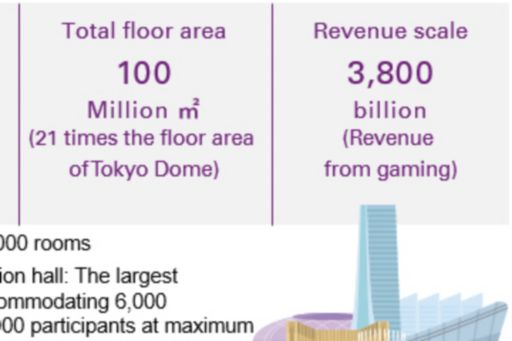Close-up 3: Challenges in making Japan a tourism-oriented country: Why deregulate Casinos?
Challenges in making Japan a tourism-oriented country
Under the Act on Promotion of Development of Specified Complex Tourist Facilities Areas (so-called “Integrated Resort (IR) Promotion Act”) passed in the Japanese Diet in 2018, casino operations are legalized, which had been prohibited as gambling under the criminal code in Japan.
Casino facilities will be integrally developed and operated within large-scale integrated resort (IR) facilities owned and run by private entities. However, the introduction and promotion of IR does not mean only the lifting of the ban on casinos. It has a very important public policy mission for Japan. The first IR facilities are expected to be open in the mid-2020s. The facilities will be built on a large scale and are reported to require total investments ranging from hundreds of billions to as much as one trillion yen. This article discusses the ambitious measures the Japanese government intends to take following the lifting of the ban on casino operations in Japan.
Final piece integral to the realization of Japan as a tourism-oriented country
The government of Japan has identified the tourism industry as a pillar of its growth strategy and has undertaken various initiatives to meet the demands of overseas visitors coming into the country. Partly through the government’s efforts, the number of incoming tourists surpassed 30 million for the first time in 2018, and altogether they consumed goods and services exceeding JPY4.5 trillion in value. Looking ahead, the government has set ambitious targets of 60 million incoming visits and JPY15 trillion in consumption by the year 2030. Japan will be hosting various global events such the Tokyo Olympic Games in 2020 and Osaka International Exhibition in 2025. In order to capture a continuous inflow of foreign tourists even after 2025, the introduction of IR facilities is now expected more than ever.
In its aim to make Japan a tourism-oriented country, what does the government intend to achieve by leveraging vast revenues from casino operations? IR refers to large-scale complex-type resort facilities consisting of casinos and entertainment facilities, in addition to accommodations, convention halls, restaurants and cafes and retailers.
The Marina Bay Sands (MBS), an iconic IR facility in Singapore, can be seen as a benchmark for the Japanese version of IR. The MBS as a world-class landmark has enhanced the image and appeal of Singapore and has grown to become one of the world’s major urban resort destinations.
Back in 2005, Singapore was losing its appeal as an international tourism-oriented city state. Lee Hsien Loong, the Singaporean prime minister at that time, decided to promote the development of an IR with a casino as a national policy with the aim of regaining the status as an international tourism-oriented city state. Despite the global financial crisis, the so-called Lehman shock, hit in the late 2000s, the large-scale IR facilities have brought about a significant and continuous increase in the number of overseas visitors and domestic consumption. In addition, as seen in Singapore having grown to a global player in the Meeting, Incentive, Convention, Exhibition (MICE) market, the government-led IR promotion has become one of the most successful examples of the public policies.
As the meaning of IR promotion, the Japanese government refers to the public benefits of making Japan a globally competitive tourist destination that attracts many visitors and encourages them to stay longer. It also insists that the IR facilities can work as tourist hubs to send foreign visitors to different locations throughout the country. Casino operations have thus been permitted on the assumption that the development of large-scale tourism bases will contribute to the goal of promoting tourism across Japan to serve the public good. The area used for casino operations is regulated to be no more than 3% of the total floor area of the vast IR facilities. Focusing solely on the lifting of the ban on casinos provides no insight into the essence of the introduction of the IR model. The economic and social effects of Japan’s transformation into an advanced tourism country need to be noted. The Japanese version of IR will be subject to the world’s first two-phase regulation models. The first phase of regulation is controlled under a Casino Management Committee. The second is controlled under the Minster of Land, Infrastructure, Transport and Tourism. Importantly, the world’s most stringent regulatory oversight will be provided in conjunction with the lifting of the casino ban, including an initiative to use a portion of revenue from IRs to combat gambling addiction in Japan.
Image of Public Interest Embodied by IR

Another pillar: Promotion of MICE
There are some core facilities necessary in all IR facilities, dictated in the IR Promotion Act. Japanese IR facilities comprise MICE facilities (exhibition hall and international convention center), attractiveness-enhancing facilities, tourist hub facilities, and accommodations, in addition to casino facilities. The IR facilities are expected to achieve a physical scale and levels of quality never seen before in Japan, and will be developed in a comprehensive and integrated manner. Crucially, the IR facilities should appeal to business travellers as well as family customers, to ensure that the benefits that IR projects generate are maximized. It is expected that the facilities must be unique, leveraging the vitality of the private sector combined with the creativity of each region where they are based. As the ban on gambling being lifted as a special exemption, it is important that IR facilities in Japan are required to maintain a certain level of public interest.
As a result, integral development of highly profitable casinos and other core facilities will lead to the establishment of a businesses model in which casino revenue internally subsidizes vast initial investments. Singapore’s extremely high yielding MBS posts an EBITDA margin of over 50% from its entire IR business. The initial investment, reportedly reaching more than JPY500 billion, is said to be recouped in just more than four years. For a large-scale real estate development project like this, the resort has realized an astonishing returns on investment.
The most difficult challenge for operators to address in their investment planning is said to be how “MICE facilities” are to attain a scale and quality consistent with those of other facilities. A casino is fundamentally defined as a business model centered on weekend operations. MICE facilities, which can be operated on weekdays, will help level the operations of entire IR facilities, including accommodations. As MICE can be compatible with casino in this sense, the IR facilities in Singapore as well as in Las Vegas are both accompanied by large-scale MICE facilities to evoke business-related demands.
Development of large-scale MICE facilities alone, has proven to be low in profitability around the world. With the vast initial investment being challenging to recoup, decisions of reinvestment is naturally difficult to make too. Therefore projects of this type are often promoted by central or local governments for the public interest. In Japan, a local government with a low fiscal surplus may find it difficult to develop and operate new large-scale MICE facilities.
On the other hand, the strong economic knock-on effect arising from a MICE event is extremely noteworthy. While the presence of Japan in the global MICE market has been declining, an international convention participant visiting Japan consumes an average of JPY360,000 during the stay, or more than double the JPY160,000 spent by a general tourist. The promotion of MICE is also consistent with the government’s policy to increase consumption by foreign visitors.
In addition to the direct consumption activities of participants in a MICE event, new agreements and the creation of new business opportunities associated with business meetings and advertisement activities are also expected. Though annual revenues of the Tokyo Big Site in 2017 was only JPY21.2 billion, the economic effect arising from exhibitions and other events at the venue has been preliminarily estimated to reach JPY750 billion annually.
The operating rate has almost peaked, however, among the landmark facilities in the Greater Tokyo Metropolitan area such as the Tokyo Big Site, the Tokyo International Forum, and Pacifico Yokohama. Opportunity losses have in fact been identified. High-end conference venue with the capacity of 1,000 participants or more are extremely difficult to find in the metropolitan area, and large hotels and attractive leisure facilities have rarely existed around them.
Thus, the Japanese version of IR facilities embodies the intention and desire of the Japanese government to regain its presence in the global MICE market by leveraging the internal subsidy mechanism to inter-relatedly develop highly profitable casino facilities and world-class MICE facilities.
Paradox inherent in the Japanese version of IR
“Tourist hub facilities” can be regarded as core facilities unique to the Japanese version of IR. Overseas IR facilities themselves are the destination, a place where every need is fulfilled and accordingly takes the name “integrated resort.” The business model is built around the intention to persuade visitors to stay longer and spend more money and time at one place.
On the contrary, the Japanese version of the IR has been identified as an initiative to disseminate the attractiveness of Japan across the world. Ways and means to send tourists to every corner of Japan have therefore been explored. Those who try to maximize the revenue, however, find a paradox built into the business. This is partly because 60% or more of visitors to Japan currently concentrate their visits along the so-called golden route connecting the three largest metropolitan areas in the country. The government intends to address the structural inequity faced by the areas remote from the golden route, which have been missed out on the benefits of the growing numbers of foreign tourists visiting Japan.
Operators are accordingly expected to commit to sending tourists to areas remote from the golden route by holding tourism expositions that use cutting-edge technologies such as VR to embody unique Japanese traditions, cultures, and arts that tourists have yet to discover. By committing to sending tourists to every corner of Japan, operators are practically obliged to return a part of casino revenues for the public interest.
The world’s largest urban IR facility - An IR business model designated by Osaka

*Prepared by KPMG based on the Osaka Government website
Leveraging IR to promote regional economies
The ultimate objective of the IR Promotion Act envisaged by the government is to help promote regional economies and thereby contribute to the improvement of finances of local governments. In practice, Japan’s prefectural governments have already started their promotions of IR facilities. Local governments are going to publicly seek their partnering private operators. The race among the pairs of local governments and selected private sector operators for the maximum of three locations for the Japanese IR development projects is already gaining steam and is carefully watched by the Japanese public as a whole.
Major regulations imposed by the government on operators could potentially constrain their businesses. Sufficient profitability that justifies the vast amounts invested would therefore be required as a condition precedent in entering into the business. Operators would select prospective areas to operate business, taking into account the government’s intentions, particularly with regard to the scale and quality of the core facilities and the creativity unique to the local governments to differentiate their appeals.
Meanwhile, a local government that eventually selects an operator may place extreme emphasis on the operator’s ability to procure funds, in addition to the business plans, given the vast investment required for the development and operation of IR facilities. In fact, it can be argued that financial institutions neither the government nor operators, could be holding the key to success in IR leveraged-promotion of the regional economies, as they are the ones to provide an unprecedented scale of finance to the country’s first-ever large IR development projects, with a limited forecast on the cash flow.
Author
Takashi Kurihara
Lead, Hospitality & leisure, KPMG in Japan
Partner, KPMG FAS Co., Ltd.
Since 2000, Takashi Kurihara has been engaged in various projects of M&As, corporate restructuring, and fund raising by tourism/hospitality operators of hotels, golf courses, and other leisure facilities. He has provided a wide range of advisory services from business analysis and assessment of target facilities, to operational restructuring, and development of turnaround plans for troubled companies. He has been a member of KPMG Japan IR Advisory Group since 2016.
KPMG FAS Newsletter Driver Vol. 04 June 2019
© 2024 KPMG AZSA LLC, a limited liability audit corporation incorporated under the Japanese Certified Public Accountants Law and a member firm of the KPMG global organization of independent member firms affiliated with KPMG International Limited, a private English company limited by guarantee. All rights reserved. © 2024 KPMG Tax Corporation, a tax corporation incorporated under the Japanese CPTA Law and a member firm of the KPMG global organization of independent member firms affiliated with KPMG International Limited, a private English company limited by guarantee. All rights reserved.
For more detail about the structure of the KPMG global organization please visit https://kpmg.com/governance.

